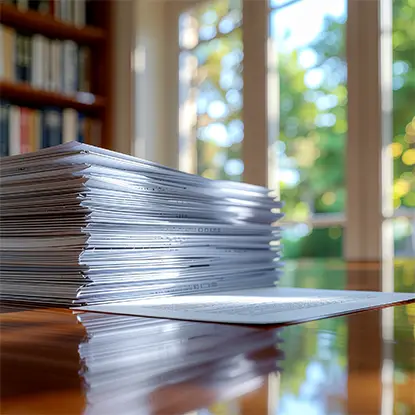The Role of Generative AI in Legal Drafting: Opportunities and Risks


Published: October 28, 2025
Technology is revolutionizing legal document preparation nowadays in the dynamic legal world. The largest innovation over the last couple of years is the innovation of generative AI, a section of artificial intelligence that is capable of generating text that is likely to be indistinguishable from human writing. From contracts and agreements to notices, legal AI-enabled tools now assist attorneys, paralegals, and small businesses in drafting proper and consistent documents in bulk. With them, though, come enormous risks and ethical issues that cannot be avoided.

Leverage docAlpha’s intelligent process automation to capture, classify, and extract data from case files, contracts, and compliance records with unmatched precision.
Generative AI offers a number of game-changing benefits for legal professionals and law firms handling documents:
Preparation of legal documents has, hitherto, been a time- and labor-intensive exercise, involving repetitive mundane tasks such as formatting, inclusion of boilerplate provisions, and cross-references to the respective laws. AI-based solutions eliminate such drudge work and allow the experts to focus on their advisory roles. For example, document automation software used in combination with AI can prepare contracts, non-disclosure agreements, and even promissory notes with minimal interference from humans.
Recommended reading: How Intelligent Automation Is Revolutionizing Document Processing in the Legal Industry
Legal document faults can lead to massive loss, both financial and legal. Generative AI reduces human error by duplication of content automatically and consistency in documents. Machine learning-based algorithms also detect inconsistencies or missing clauses, so the documents will be consistent with governing legislations. Professionals can further improve document accuracy by studying how to get a free promissory note template, which helps ensure standard formatting and compliance in basic legal drafts.
Transform Legal AP With AI-Driven Invoice Automation
InvoiceAction automates invoice intake, validation, and approval - reducing errors, ensuring compliance, and speeding up legal vendor payments.
Book a demo now
By automating part of the drafting process, businesses are able to save time and money. This is particularly useful to smaller or medium law firms or businesses which may not have, for the sake of necessity, vast legal departments. Intelligent automation technology can handle template documents in a way that employees can focus on tasks involving human judgment, such as client consultations and strategic business decision-making.
Generative AI opens up an opportunity window for law firms and enterprises to use templates and build documents even when they have no major experience. Legal documents become democratized due to this ability, and it is feasible to create required agreements on an efficient level of scale without compromising on legality.
Recommended reading: How AI is Transforming Financial Institutions
Even with the global benefits, generative AI application in the drafting of law does have its own list of problems:
AI excels where there are patterns to be recognized and text created based on given information. Legal language is a more sophisticated interpretation AI cannot easily manage. A case in point would be, for instance, heavily saturated jurisdictional facts or conditions ad hoc, possibly overlooked, resulting in potentially less-than-ideal documents unless vetted by trained professionals.
Completely depending on AI for generating legal documents will have compliance implications. Compliance differs from state to state within the USA and from country to country, and the off-the-shelf document created by AI will not be compliant with local law. Lawyers and businesses need to ensure that documents created by AI are checked and altered to meet the relevant legislation and industrial standards.
Simplify Client Request Orders With AI
OrderAction automates the capture and validation of client purchase orders for legal services - improving intake speed and reducing miscommunications.
Book a demo now
Generative AI software would require access to confidential information to produce adequate drafts. This is a data privacy and security threat. Legal professionals must have strict controls guarding client information and not releasing confidential information while drafting.
While computers can mechanize, overdependence on automated procedures will stifle essential thinking and professional advice. Legal drafting is a combination of experience, human judgment, and analytical ability - functions beyond the capabilities of computers. Specialists must employ AI as an assistant and not a replacement.
Recommended reading: How AI Algorithms Transforming Intelligent Process Automation
Legal professionals can utilize best practices while working with generative AI as part of document automation procedures to maximize benefit and mitigate risk:
Unlock AI-Powered Legal Intelligence
From pleadings to discovery, docAlpha uses machine learning to understand document context and route information accurately across your legal tech stack.
Book a demo now
Generative AI legal drafting will increase as document management systems and machine learning software become more advanced with intelligent automation solutions. From collaborative cloud-based drafting to AI-based analytics for enabling strategic decision making, the legal profession is being revolutionized by technology. Law firms using AI responsibly can enhance their productivity, consistency, and compliance without guaranteeing that human judgment must remain in control of critical decisions.
Recommended reading: How Can AI & Machine Learning Improve Financial Decisions?
Generative AI holds so much promise for legal drafting, capable of producing documents quicker, more predictably, and less expensively. But the temptations of ethics, regulatory needs, and context limitations must be well contained. Legal professionals can get past these hurdles by marrying AI-powered automation with best practices and human judgment, in this manner leveraging technology to automate document processes.
Recommended reading: AI Automation: What It Is and How It Works in 2025